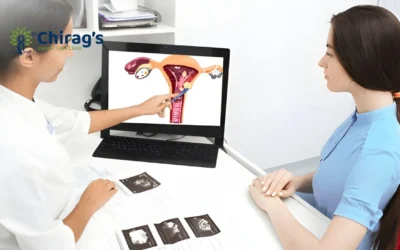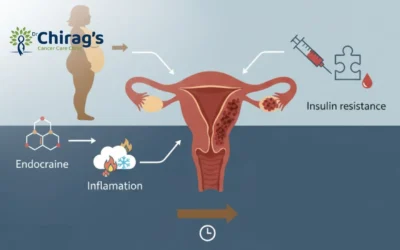Is Endometrial Cancer The Same As Uterine Cancer?

This is one of the most frequent and important questions I hear in my clinic, especially here in Pune where women are becoming increasingly health-conscious.
As a cancer specialist, I can tell you the short answer: Uterine Cancer is a broad term, and Endometrial Cancer is its most common form.
Is Endometrial Cancer The Same As Uterine Cancer, Really?
Think of the uterus (or the womb) as having two main layers, like a beautiful, essential pear-shaped organ. The inner lining, which sheds every month during your cycle, is called the endometrium.
Cancer that starts here—which accounts for about 90% of all uterine cancer cases—is what we call Endometrial Cancer. It’s a carcinoma, meaning it originates in the epithelial cells.
The remaining, rarer cases typically involve the muscle wall (myometrium) and are known as uterine sarcomas, which behave and are treated differently.
So, while not exactly the same, when people or even news reports talk about ‘uterine cancer,’ they are usually referring to the far more common Endometrial Cancer. Understanding this distinction is the first critical step in your journey toward healing and awareness.
What Signs or Symptoms Should I Be Looking Out For?
The body speaks to us, and in the case of uterine cancers, its voice is often loud and clear. The single most important symptom you should never ignore is abnormal vaginal bleeding. This primarily means any bleeding after menopause.
If you have crossed menopause, even a single spot of blood warrants an immediate check-up. For younger women, this could present as bleeding between your regular menstrual periods or periods that suddenly become much heavier or longer than usual.
Less common symptoms can include a watery or discolored vaginal discharge, or perhaps a dull, persistent pain or cramping sensation in the pelvic area. The silver lining with Endometrial Cancer is that this clear warning sign—the bleeding—means the cancer is often detected at a very early, highly curable stage.
We also need to be mindful of risk factors, particularly the link between excess estrogen exposure, which often comes with conditions like obesity and diabetes, and the development of uterine lining cancer in India.
How Exactly Do Doctors Diagnose Endometrial Cancer?
The path to a definitive diagnosis must be systematic yet reassuring. When you first consult, a detailed medical history and a gentle pelvic examination are always the starting point. Next, we rely on a few key diagnostic tools.
A Transvaginal Ultrasound (TVS) is crucial; it helps us visualize the uterus and precisely measure the thickness of the endometrial lining. If the lining looks abnormally thick, the next step is typically an Endometrial Biopsy.
I assure my patients that this is a quick, minor outpatient procedure, often feeling like strong menstrual cramping, where we take a tiny tissue sample from the lining. This sample is then examined under a microscope by a pathologist.
This biopsy is the gold standard—it confirms if cancer cells are present and, if so, what type they are. If the biopsy is inconclusive or the cancer is confirmed, we then use advanced imaging like CT or MRI scans to understand the extent of the disease, a process called staging.
If I Have It, How Advanced Is My Cancer? (Understanding the Stages)
Cancer staging is how we scientifically measure how far the disease has progressed; it’s our map for planning treatment. In the FIGO system, Endometrial Cancer Treatment is generally described in four main stages.
Stage I means the cancer is confined to the uterus itself, which is where the vast majority of cases are found. This early detection is why the five-year survival rates for Stage I Endometrial Cancer are exceptionally high.
As the stage number increases, it indicates spread to nearby structures—Stage II to the cervix, Stage III to areas like the pelvis or lymph nodes, and Stage IV means distant spread to organs like the lungs or liver. Importantly, the type of cells also matters.
While most are slow-growing (endometrioid adenocarcinoma), some rarer types are more aggressive, demanding immediate and focused management.
What Are the Best Treatment Options Available to Me?
For most women diagnosed with Endometrial Cancer, the primary and most curative treatment is surgery. This usually involves a Total Hysterectomy and Bilateral Salpingo-Oophorectomy—the removal of the uterus, cervix, fallopian tubes, and ovaries.
My expertise as a specialized Onco Surgeon is centered on performing this procedure with precision, often using minimally invasive techniques like laparoscopic or robotic surgery.
This approach minimizes scarring, reduces post-operative pain, and significantly speeds up recovery. During this surgery, meticulous lymph node sampling (often using the Sentinel Lymph Node technique) is essential for accurate staging.
Based on the surgical findings and the stage of the cancer, we may recommend additional ‘adjuvant’ treatments like radiation therapy (Brachytherapy or external) or chemotherapy to eliminate any microscopic residual disease.
What Does Life Look Like After Treatment, and How Do I Cope Emotionally?
The end of treatment is the beginning of recovery, and it’s a journey we walk together. Physically, the initial recovery from surgery takes a few weeks, but full energy levels return over a few months.
Since the ovaries are often removed, you will likely experience immediate, surgical menopause, and we are here to manage those symptoms with appropriate support. Just as important is the emotional landscape.
The diagnosis and treatment of cancer are profound experiences. It is absolutely normal to feel fear, anxiety, or grief. I always encourage my patients to lean on their support networks, utilize counseling services, and practice self-care.
Post-treatment life is all about surveillance—regular follow-up visits, which include clinical examinations and sometimes blood tests or imaging, are scheduled to ensure you remain cancer-free and to catch any recurrence early.
Frequently Asked Questions (FAQs)
1. Is Endometrial Hyperplasia a type of cancer?
No, Endometrial Hyperplasia is a non-cancerous condition where the lining of the uterus becomes too thick. However, certain types, especially ‘complex atypical hyperplasia,’ are considered pre-cancerous and can turn into cancer, so they require close monitoring or treatment.
2. Can a Pap Smear detect Endometrial Cancer?
Generally, no. A Pap smear is a screening test designed to find abnormal cells on the cervix to detect cervical cancer. It is not an effective tool for screening the inner lining of the uterus (endometrium).
3. If I have fibroids, am I at a higher risk for Uterine Cancer?
Fibroids (leiomyomas) are extremely common, non-cancerous muscle tumors of the uterus and do not increase the risk of Endometrial Cancer. However, both fibroids and uterine cancer can cause similar symptoms like heavy bleeding, making an accurate diagnosis by a specialist crucial.
4. Does taking Tamoxifen for breast cancer increase my risk?
Yes, long-term use of Tamoxifen, a hormone therapy for breast cancer, is associated with a small, but real, increased risk of developing Endometrial Cancer. The benefits usually outweigh this small risk, but you must report any abnormal bleeding to your doctor immediately while on this medication.
5. Is there a genetic test for Uterine Cancer?
While Uterine Cancer is not typically considered a hereditary cancer, a small percentage of cases are linked to an inherited condition called Lynch Syndrome. If you have a strong family history of colon, ovarian, or uterine cancers, genetic counseling and testing for Lynch Syndrome may be recommended by your specialist.
Conclusion
My message to every woman reading this is simple: Listen to your body. Abnormal bleeding is not a minor inconvenience—it is a signal that demands attention.
Endometrial cancer is a highly curable disease when caught early. Do not delay your consultation out of fear or embarrassment. My commitment, as Dr Chirag Bhirud, Expert Onco Surgeon Doctor is to blend surgical excellence with genuine human care, ensuring you feel fully informed and supported throughout your treatment.
If you have any further queries, please write to us.
Latest Blogs
Does endometrial cancer cause postmenopausal bleeding?
Postmenopausal bleeding is never normal and can be an early sign of endometrial cancer. Learn causes, risks, tests, and treatment guidance from a leading cancer specialist in Pune.
Does Fluid in the Endometrial Cavity Mean Cancer?
Fluid in the endometrial cavity doesn’t always mean cancer. Learn causes, diagnosis, and treatment from Dr. Chirag Bhirud, Cancer Specialist in Pune.
Obesity & Endometrial Cancer: What’s the Connection?
Learn how obesity raises endometrial cancer risk. Dr. Chirag Bhirud, Onco Surgeon in Pune, explains causes, symptoms, and preventive care in simple terms.






